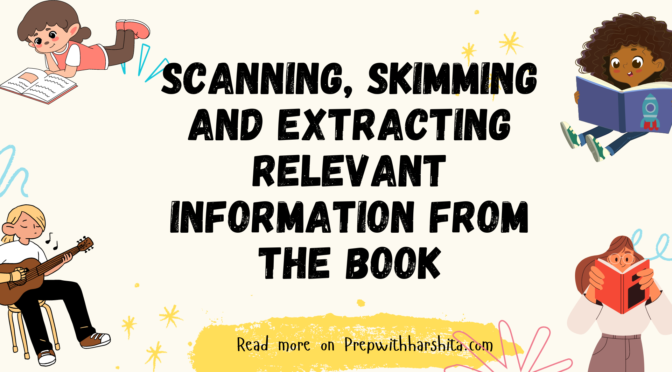Scanning skimming and extracting information from the book is an important skills for efficient and effective reading. Here’s a detailed explanation of each technique:
- Scanning: Scanning is a reading technique used to quickly locate specific information within a text. It involves moving your eyes rapidly over the text to search for keywords, phrases, or specific details. Here’s how to effectively scan a book:
a. Identify the Purpose: Determine the specific information you are looking for before starting to scan. This could be a particular fact, statistic, name, or any other specific detail.
b. Focus on Visual Cues: Pay attention to headings, subheadings, bold or italicized text, bullet points, or any other visual cues that can guide you to the relevant information.
c. Use Eye Movement: Instead of reading every word, move your eyes quickly across the text in a zigzag or diagonal pattern. Train your eyes to pick up keywords or phrases related to your search.
d. Ignore Irrelevant Information: While scanning, avoid getting caught up in reading the entire text. Stay focused on locating the specific information you need and ignore irrelevant details.
e. Mark or Note: When you find the relevant information, mark it or take notes for future reference. This will help you easily retrieve and use the information later.
Scanning is particularly useful when you have a specific question or need to find information quickly without reading the entire book.
- Skimming: Skimming is a technique used to get a general overview of a text quickly. It involves reading rapidly to grasp the main ideas, key points, and structure of the text. Skimming is useful when you want to determine whether a book or chapter is relevant to your needs or to gain a quick understanding of the content. Here’s how to effectively skim a book:
a. Preview the Text: Start by reading the title, subtitles, headings, and subheadings. Look at any graphics, captions, or diagrams that provide visual information about the content.
b. Read the Introduction and Conclusion: Read the opening and closing paragraphs or sections, as they often summarize the main ideas or arguments presented in the text.
c. Focus on Topic Sentences: Read the first sentence or two of each paragraph. Topic sentences usually provide a concise summary or highlight the main point of the paragraph.
d. Note Keywords and Phrases: Pay attention to keywords, phrases, and any bold or italicized text that convey important information. These elements can help you understand the main ideas or concepts in the text.
e. Skip Unnecessary Details: While skimming, don’t get caught up in reading every word. Move quickly through the text, skipping irrelevant details or sections that are not directly related to your purpose.
Skimming allows you to quickly assess the content and structure of a book, helping you decide if it contains the information you need or if you should explore further.
- Extracting Relevant Information: Once you have scanned or skimmed a book and identified the relevant information, it’s important to extract and organize that information for later use. Here are some techniques to extract relevant information effectively:
a. Note-Taking: Take notes on the key points, facts, or ideas that you find relevant. Summarize information in your own words and include any supporting details or examples that are important.
b. Highlighting or Underlining: Use highlighting or underlining to mark relevant passages or sentences directly in the book. This makes it easy to find and reference the information later.
c. Organize Information: Create an organized system for storing and categorizing the extracted information. This could be through digital tools like note-taking apps or by using physical methods like index cards or color-coded folders.
d. Summarizing: Summarize the extracted information in a concise and coherent manner.
Also Read : Role of Teacher in LAC

Also Visit : Prep with Harshita

